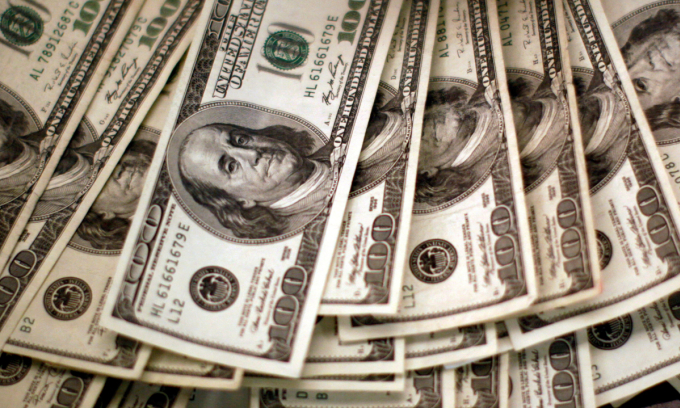U.S. President Donald Trump has imposed substantial tariffs on its major trading partners in a move that escalated global trade tension, prompting the affected countries to retaliate with duties on U.S. goods.
1. Which countries were hit by the tariffs?
Trump has imposed 25% tariffs on the nation's two largest trade partners, Canada and Mexico, effective Tuesday. He also announced a 10% tax on Canadian energy.
On the same day Trump doubled the tariffs on Chinese goods to 20%, and threatens to impose port entry fees on Chinese-built ships.
 |
|
U.S. President Donald Trump speaks at Capital Hill on March 4, 2025. Photo by AP |
Last year, Mexico exported roughly $505 billion to the U.S., roughly 30% of its GDP, while Canada exported over $412 billion, about 20% of its GDP.
China is a significant buyer of American agricultural products. Its imports decreased when Trump initiated a trade war during his first term but later rebounded.
2. Which sectors will be most affected?
Canada’s automotive and energy industries are likely to face significant impacts, as the U.S. Census Bureau reports that approximately $185 billion in goods from these sectors are shipped from Canada to the U.S.
Canadian automakers will encounter increased taxes when exporting vehicles and parts to the U.S., potentially leading to temporary production halts as they seek ways to manage the added costs, said Drew Fagan, a professor at the University of Toronto’s Munk School of Global Affairs and Public Policy, as reported by CNN.
Mexico’s auto industry, closely linked to the U.S. and reliant on its consumers, could also be affected. The U.S. brought in $87 billion in motor vehicles and $64 billion in auto parts from Mexico last year, not counting December, according to the Department of Commerce.
Tariffs would raise the price of these goods for American buyers, possibly reducing demand from Mexico and impacting its economy as a result, analysts have said.
The 20% tariffs on China will apply to several major U.S. consumer electronics imports previously untouched by prior duties, including smartphones, laptops, videogame consoles, smartwatches and speakers and Bluetooth devices.
3. Why did Trump escalate trade tension?
Trump announced the tariffs after repeatedly saying that the top three U.S. trading partners had failed to do enough to stem the flow of fentanyl and its precursor chemicals into the U.S.
Trump asserts that Canada and Mexico have been facilitating the movement of fentanyl and undocumented immigrants into the U.S., labeling it a "national emergency." Through the imposition of hefty tariffs on both countries, Trump apparently seeks to pressure them into halting the influx of drugs and migrants.
However, the U.S. President has assured that if companies move their production to the U.S., they will be subject to no tariffs.
 |
|
Workers stand next to cranes at the new megaport being built by China's state-owned Cosco Shipping, promising to shorten sea routes to Asia for Peruvian and some Brazilian goods, in Chancay, Peru October 24, 2024. Photo by Reuters |
Trump said that his tariffs are not merely a short-term tactic to address fentanyl imports but rather a long-lasting strategy to compel companies to relocate their factories to the U.S.
He argues that if the tariffs were temporary, businesses would lack incentive to alter their investment plans. Highlighting the U.S.’s significant trade deficits with Canada, Mexico, China, and nearly all nations, alongside a national debt of $36 trillion, Trump asserts that the country will no longer play the role of the "stupid country."
"Make your product in the U.S. and there are no tariffs," Trump said on social media.
Concerning China, Trump claimed that Chinese fentanyl shipments were reaching the United States through Mexico and Canada, accusing China having "subsidized and otherwise incentivized" companies to send fentanyl and related chemicals to the U.S., according to The Washington Post.
Beijing rejected these allegations, insisting that the Chinese government is not responsible for America's public health crisis.
While Trump admitted that the new tariffs might cause some hardship for U.S. consumers, he maintained they were justified. He also suggested that countries like Russia, Brazil, India, and others could face higher tariffs, and emphasized that he would "absolutely" impose tariffs on the European Union.
4. How have affected countries retaliated?
Canadian Prime Minister Justin Trudeau described the tariffs as "a very dumb thing to do" and hit back with 25% tariffs on CAD30 billion (US$20.7 billion) worth of U.S. imports, including orange juice, peanut butter, wine, spirits, beer, coffee, appliances and motorcycles.
Beyond the actions he announced on Tuesday, Trudeau said Canada would impose tariffs on another CAD125 billion of U.S. goods if Trump's tariffs were still in place in 21 days, likely to include motor vehicles, steel, aircraft, beef and pork. Canada also will challenge the U.S. tariffs under rules of the WTO and the U.S.-Mexico-Canada free trade agreement.
"They've chosen to launch a trade war that will, first and foremost, harm American families," Trudeau said of the Trump administration.
Mexican President Claudia Sheinbaum took a softer approach, vowing retaliation but without details, saying she would announce Mexico's response on Sunday.
China responded immediately, announcing additional tariffs of 10%-15% on certain U.S. imports from March 10 and a series of new export restrictions for designated U.S. entities. Later it raised complaints about the U.S. tariffs with the World Trade Organization.
The trade tension will likely intensify. Trump has threatened to hike tariffs on Canadian goods even higher, in an apparent reference to a U.S. plan to impose "reciprocal tariffs" on global trading partners on April 2.
"Please explain to Governor Trudeau, of Canada, that when he puts on a Retaliatory Tariff on the U.S., our Reciprocal Tariff will immediately increase by a like amount!" Trump wrote in a post on his private social media platform.
5. What are the economic impacts of the trade war?
The tariff actions, which look set to upend nearly $2.2 trillion in annual trade.
The U.S. imports $900 billion of goods a year from Canada and Mexico. The three countries have highly integrated supply chains in the automotive industry, where parts can cross borders several times in the manufacturing process, and substantial cross-border trade in industrial goods, aerospace, agriculture and energy, Reuters reported.
The tariffs have immediate prompted a global stock sell-off. Major U.S. indexes ended lower Tuesday, with the tech-heavy Nasdaq veering into correction territory, while shares of automakers, homebuilders, retailers and other tariff-sensitive firms all took hits.
The tariffs were already sparking some U.S. price increases, running counter to Trump's election vow to bring down living costs for Americans.
Target CEO Brian Cornell told CNBC that the retail giant would increase prices "over the next couple of days" on some seasonal grocery products such as avocados from Mexico.
"If there's a 25% tariff, those prices will go up ... certainly over the next week," Cornell said.
Electronics retailer Best Buy also warned of potential higher prices as the tariffs came into effect. Best Buy CEO Corie Barry told analysts on a call that China remains the top source of products sold by the company, with Mexico in second place.
Barry said the price increases could play out over a longer period, as Best Buy typically carries about six weeks' worth of inventory.
"We estimate the tariffs could lead to a nearly $1,000 per household increase annually in the cost of goods," said Nationwide Mutual chief economist Kathy Bostjancic. "The strengthening dollar helps mitigate some of the inflation impact, which would otherwise be greater."




